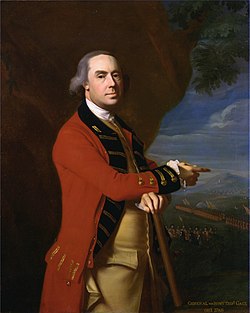| Portrait of Thomas Gage | |
|---|---|
 | |
| Artist | John Singleton Copley |
| Year | 1768 |
| Type | Oil on canvas, portrait |
| Dimensions | 127 cm× 101 cm(50 in× 40 in) |
| Location | Yale Center for British Art, New Haven, Connecticut |
Portrait of Thomas Gage is a 1768 portrait painting by the American artist John Singleton Copley depicting the British general Thomas Gage.
Gage was Commander-in-Chief of the British Army in North America having served there during the Seven Years' War. Gage was paying a visit from his headquarters in New York to Boston where Copley was based. The commission marked an important step forward in Copley's career. [1] He depicts the general in the style Joshua Reynolds used for military portraits. [2]
Once completed, Gage hung it prominently in his house in Broad Street in New York. [3] Gage then shipped it to London where it hung in the general's residence in Arlington Street in Piccadilly and was widely admired, a further encouragement for Copley's later move to Britain. [4]

Today it is in the collection of the Yale Center for British Art in Connecticut. [5] Copley also painted his American-born wife Margaret Kemble Gage a few years later in his Mrs. Thomas Gage .